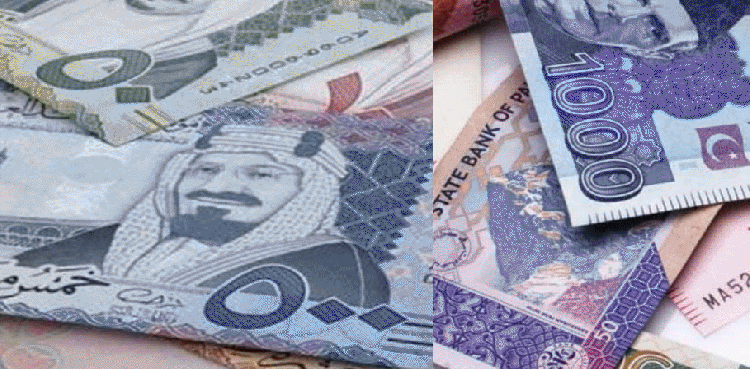Karachi, May 10, 2025 – The Saudi Riyal (SAR) remained stable against the Pakistani Rupee (PKR) and was at an open market rate of 74.97 PKR, based on the recent updates of the Forex Association. The stability shows an even interplay of economic forces, such as strong remittance inflows and managed speculative flows, that have supported the currency market of Pakistan.
Valuation Process of the Saudi Riyal vs. the Pakistani Rupee
The Saudi Riyal’s exchange rate against the Pakistani Rupee is fixed in the open market where demand and supply forces determine the exchange rate. The Saudi Riyal is fixed against the U.S. Dollar at a value of 3.75 SAR to 1 USD, a policy since 1986, and therefore stabilizes its value against other currencies such as the PKR indirectly. In Pakistan, the exchange rate is determined by several factors:
Remittance Inflows: A large percentage of the foreign exchange holdings of Pakistan constitutes remittances from diaspora expatriate workers in Saudi Arabia. These inflows provide a boost to the market offer of Saudi Riyals and lead to stabilisation of the corresponding exchange rate accordingly.
Trade Balance: Saudi-Pak business relations, including foreign investment and trade, will dictate demand for SAR. Healthy trade operations generate stability in exchange rates.
Forex Reserves and Monetary Policy: State Bank of Pakistan monitors the currency market and, occasionally, intervenes for stability. Adequate foreign exchange reserves provide a cushion against sudden fluctuations.
Market Speculation: Reduced speculative activity, which has been observed in recent days, has been the reason behind Riyal’s stable performance against the PKR.
The prevailing rate of 74.97 PKR is a minor upturn from weeks past, in line with expectation of a range of 73.72 to 76.06 PKR for May 2025. This stability is further contributed to by Pakistan’s improved economic indicators, including a strong stock market and sustained foreign inflows.
Impact on Pakistan’s Society and Economy
The Saudi Riyal’s fixed exchange rate has several effects on the economy and citizens of Pakistan:
Remittance-Dependent Households: With 2.5 million estimated Pakistani workers in Saudi Arabia, remittances constitute a survival strategy for the majority of families. A stable SAR-PKR exchange rate offers a reliable income source for households, funding daily livelihood, education, and domestic economic activity.
Trade and Investment: The stable exchange rate gives business confidence in doing business with Saudi Arabia, especially in industries such as petroleum, textiles, and food exports. It also enables Saudi investment in Pakistan, according to schemes such as the
Special Investment Facilitation Council (SIFC). Travel and Pilgrimage: Stability benefits Pakistani pilgrims who travel to Saudi Arabia to perform Hajj and Umrah because it ensures equal rates for currency exchange, thereby lowering religious travel costs.
Price stabilization: A firm Riyal has a balancing impact on imported price inflation, primarily for Gulf-priced currencies, such as oil that is required in Pakistan for meeting its energy demand.
However, one such risk is the external shocks, i.e., volatility in global oil prices or U.S. monetary policy, which can indirectly affect the Riyal’s peg against the USD and consequently its value in PKR.
Introduction to Pakistani Rupee and Saudi Riyal Saudi Riyal (SAR): The Saudi Riyal, the official currency of Saudi Arabia, is abbreviated as SAR or SR and is also divided into 100 halala. It is issued by the Saudi Central Bank and has been pegged to the U.S. Dollar since 1986 for foreign exchange stability.
The Riyal has a history dating back to the establishment of Saudi Arabia in 1932, from bimetallic to fiat currency by 1959.
Saudi Arabia’s Vision 2030 and recent events, including the introduction of a new Riyal symbol in February 2025, highlight its status as a symbol of economic aspiration for the Gulf region.
Pakistani Rupee (PKR): Rupee, symbolized by PKR or Rs, is the official currency of Pakistan and is subdivided into 100 paisa. Rupee is regulated by the State Bank of Pakistan and is regulated under a managed float regime, where its exchange value is decided by market forces and the occasional intervention of the central bank. The value of the Rupee is closely tied to the performance of the economy of Pakistan, remittance inflows, and trade patterns, particularly with major trading partners like Saudi Arabia. The fixed exchange rate of the Saudi Riyal at 74.97 PKR is a clear sign of economic stability for Pakistan, driven by strong remittance flows and trade balance with Saudi Arabia. Not only does this stability support Pakistan’s millions of families, but it also supports bilateral economic ties. With the two nations strengthening their financial and cultural bonds, the SAR-PKR exchange rate will remain a critical metric of Pakistan and Saudi Arabia’s combined prosperity.


Leave a Comment